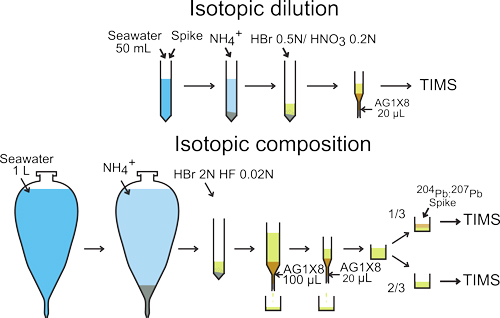A new method to measure lead isotopes in the ocean with an outstanding precision
A new method for the determination of seawater lead (Pb) isotope compositions and concentrations was developed, which combines and optimizes previously published protocols for the separation and isotopic analysis of this element. It involves 1 to 2 L of seawater, double spike, magnesium hydroxide coprecipitation, anion exchange chromatography and thermal ionization mass spectrometry. Ratios involving the minor 204Pb isotope are a factor of five more precise than previously published data, yielding uncertainties better than ±3‰. Results are presented on GEOTRACES intercalibration samples and a first depth profile from the eastern South Atlantic Ocean.

Figure: Methodology to separate and analyse Pb isotopes and concentrations from seawater samples using a 207Pb-204Pb double spike and thermal ionisation mass spectrometry (TIMS). Click here to view the figure larger.
Reference:
Paul, M., Bridgestock, L., Rehkämper, M., van DeFlierdt, T., & Weiss, D. (2015). High-precision measurements of seawater Pb isotope compositions by double spike thermal ionization mass spectrometry. Analytica Chimica Acta, 863, 59–69. doi:10.1016/j.aca.2014.12.012. Click here to access the paper.
